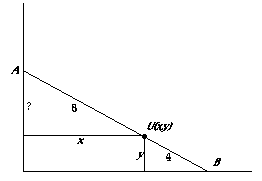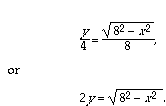Analysis of falling ladder problem
What's the equation of the curve consisting of all points lying 4 feet from the x-axis along a 12-foot line segment in the first quadrant whose endpoints are on the axes?
A major problem-solving technique is to draw a picture. Here's one:

A and B are the endpoints of the ladder. The point U is where you are standing.
Another problem-solving technique is to ask "What do we know and what do we want to find out?" We know the distance from A to U and the distance from B to U. We want to find the coordinates of point U. Actually, we want to find an equation that relates the x- and y-coordinates of U.
Can we represent the x- and y-coordinates in our picture? The x-coordinate is the distance from the vertical axis, and the y -coordinate the distance from the horizontal axis. To our picture we can add line segments whose lengths are those distances:

We now have three right triangles, if we count the big one whose right angle is at the origin. Moreover, they are all similar triangles.
For the smaller right triangle with one edge along the horizontal axis, the lengths of two edges are y and 4. If we knew the lengths of the corresponding edges in either other of the right triangles, we could make an equation. Ideally that equation would involve x, so let's look at the other smaller right triangle, with one edge along the vertical axis. In fact, the edge along the vertical axis would correspond to the edge of length y in the smaller right triangle. Unfortunately, we don't have a representation for that edge along the vertical axis. We know only the horizontal edge and the hypotenuse, which corresponds to 4 in the first right triangle. So we can only say



If we want to eliminate the square root, we can write
Have we solved the problem? The goal was to find an equation for this figure. One conjecture was that the shape is an arc of an ellipse. Does this equation represent an ellipse?
The standard equation for an ellipse centered at the origin is

We can rewrite our equation,
as
To get a 1 on the right side, we divide by 64:

Indeed, we have an equation for an ellipse, whose semimajor axis a is 8 and whose semiminor axis b is 4.









